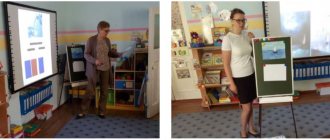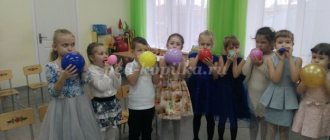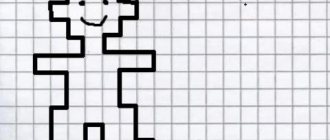"Morning filter" in preschool educational institution
“Morning filter for children in preschool educational institutions”
Resolution of the Chief State Sanitary Doctor of the Russian Federation dated May 15, 2013 N 26 approved the sanitary and epidemiological requirements for the structure, content and organization of the operating mode of preschool educational organizations" (SanPiN 2.4.1.3049-13. Sanitary and epidemiological rules and regulations...")
These rules and regulations are aimed at protecting the health of children when carrying out activities for their upbringing, training, development and health improvement in preschool organizations and establish sanitary and epidemiological requirements for the conditions of placement of preschool institutions, equipment and maintenance of the territory, catering, etc.
The daily morning reception of preschoolers is conducted by teachers who interview parents about the state of health of the children.
According to indications, the nurse examines the pharynx, skin and measures the child’s body temperature. Admission of children to the nursery group is carried out by a person with a medical education. The pharynx and skin are examined daily, and the temperature is measured. Patients and children with suspected illness identified during the morning filter are not admitted to the preschool educational institution; sick people identified during the day are isolated.
Depending on the condition, the child is isolated until the parents arrive or is hospitalized.
Once a week, a health worker examines children for head lice.
The inspection results are recorded in a special journal. If children are found affected by head lice, they are sent home (for treatment).
In order to stop the spread of various diseases during the morning admission of children to a preschool institution, kindergarten workers constantly conduct a thorough morning “filtering” (medical examination). The seasonal rise of various diseases in children occurs very often, there are many reasons for this. In this regard, in all children's institutions this issue has been under constant control for a number of years by the heads of kindergartens, namely, the mandatory and thorough implementation of the so-called “morning filter” by employees.
Before the start of the day, a medical worker or teacher carefully examines each student and always measures his temperature.
“Morning filter” is carried out in the presence of parents (legal representatives). Data about the child’s condition (temperature, condition of the skin, pharynx) are entered into a special notebook, in which parents also sign if they agree with the results of the examination of their children.
To prevent the spread of colds, intestinal and other diseases, our kindergarten constantly ensures that children arrive healthy, and those who show symptoms of illness are sent home.
After suffering from an illness, as well as absence for more than 5 days, children are admitted to a preschool educational institution only if they have a certificate from a local pediatrician indicating the diagnosis and duration of the disease.
Dear parents, we kindly ask you to be understanding about the daily “morning filter” procedure and be sure to be present when the child is examined.
Under no circumstances should you send your child to kindergarten alone!
The life and health of our children are in our hands!
Article: “SUMMARY OF THE MORNING MEETING IN THE PREPARATORY GROUP”
Municipal budgetary preschool educational institution, a general developmental kindergarten with priority implementation of activities in one of the areas of child development No. 4 “Zvezdochka”
SUMMARY OF THE MORNING MEETING IN THE PREPARATORY GROUP
Developed by : Meshkova M.V.,
teacher of MBDOU No. 4 “Zvezdochka”
Shushenskoye village
Educator: Guys, a new day has come. It's time for morning gathering. I'm glad to see everyone today. Let's rub our palms, feel the warmth of our hands, pass it on to our comrades and say kind words to each other. I convey my warmth to Diana and wish her not to be sad today, but to just smile.
The teacher shows through his actions how to convey his warmth. After this, the children repeat the teacher’s actions.
Educator: Guys, I’m in a joyful mood today, and I’m very interested to know in what mood you came to kindergarten. Children take their photo and place it in the selected pocket on the “Mood Corner” stand.
Educator: Guys, today everyone is in a joyful mood, and so that this joyful mood does not disappear, I suggest playing any game.
The children chose the game “Arms and Legs”.
Educator: Let's remember the rules of the game. One clap is a command to the hands. They need to be raised or lowered. Two claps are a command to the legs. You need to stand up or sit down.
Educator: Guys, we have a beautiful “Star of the Week”. Let's think about whose photo we will put in the pocket. But first, let's remember the rules: you don't have to offer yourself; You must explain your choice; You need to choose the “Star of the Week” from the heart and soul, without receiving any benefit.
Children make and explain their choices. Place a photo of the child in the pocket of the “Star of the Week” rolling element.
Educator: Guys, we haven’t seen you all day. During this time, many interesting events happened. Yesterday I saw a little kitten. He meowed so loudly, probably because he was hungry. I treated him to sausage. What news do you have? How many children want to talk about their events. Let's first tell the news of girls whose names begin with the sound "L".
Children share their news.
Educator: Guys, I have Dobrinka in my hands. Whoever has it in their hands, it will help. Guys, I want to share my “Dobrinka” with you. Extend your palms and hold it tightly. Hold your “Dobrinka” to your heart to make you feel warm and joyful. And I wish you a fun whole day!
Analysis of the implementation of regime moments in preparatory group No. 3
Reception of children, sleep, washing, hardening, undressing, morning exercises, etc.)
Morning reception. I came to work. I ventilated the group, reviewed the plan, and prepared manuals. Gradually the children began to arrive.
A child, in a hurry to be the first to play with building material, carelessly folds his clothes. I remind him that things need to be put neatly in the closet. The teacher simultaneously carries out various tasks: receives children, talks with parents, organizes games, and carries out the work planned for the morning. I conducted individual work with Masha on speech development, organized didactic games with several children, and had a conversation with another on the topic “What children see on the way to kindergarten.”
Then, I suggested that the children collect their toys and prepare for morning exercises. Morning exercises. I (the teacher) suggested that they line up according to their height and take the children to the gym.
After gymnastics, the children return to the group with the teacher and begin to change clothes.
Duty. Those on duty wash their hands first and put on white aprons and caps. Then the assistant teacher stays with those on duty and helps them set the table.
Washing. I suggested to the children who had already changed their clothes to go to the washroom to wash their hands. She suggested remembering the washing procedure.
Breakfast. Children gradually sit down at the tables without making noise. I wish them “Bon appetit!” At the end of breakfast, the nanny, with the help of the attendants, clears the tables. At this time, I (the teacher) are preparing for classes.
Preparing for a walk. The teacher invites the children to collect toys. Children who have cleaned up after themselves are encouraged to go to the toilet and go to the dressing room, reminding them of the dressing order. At the same time, I help the children get dressed and talk about what they will do during the walk.
Returning from a walk. At the end of the walk, I invite the children to finish playing and get together in a group. Children collect toys, line up in pairs and enter the kindergarten, wipe their feet clean on the rug and walk quietly, without making noise, along the corridor.
Preparing for lunch. I remind you of the washing procedure. Children go to the tables.
Dinner. The teacher creates a calm environment, regulates the children’s behavior at the table, and reprimands those who are naughty. Encourages children to finish their food. At the end of the meal, the children say “thank you.”
Preparation for sleep. The children gradually enter the bedroom, I warn them that they must enter quietly and not talk. They begin to undress, I make sure that the children undress in the correct sequence and carefully put their things on the chair. The teacher remains in the bedroom until all the children fall asleep.
Planning the morning time slot at the preschool educational institution
Recommendations for teachers on planning the morning period of time in preschool educational institutions.
It is necessary to remember that the morning is a calm, routine moment.
The main task of pedagogical work in the morning is to include children in the general rhythm of life of the kindergarten, to create in them a cheerful, cheerful mood. It is very important to do emotionally stimulating gymnastics here. Work is carried out in subgroups and individually. If we talk about frontal work, it can be round dances and quiet activities. Morning reception is the most favorable time for individual communication between the teacher and each child. During these hours, individual work with children on various types of activities is successfully carried out. Its distinctive feature is ease, reliance on the child’s interest and curiosity, on the entertaining form and content of the activities. This is work on correcting and educating children in correct sound pronunciation, on developing oral speech and developing correct intonation, on physical education (stimulating motor activity). When planning individual work with children, the teacher specifically indicates the names of those pupils with whom the work will be done and prescribes what kind of work. In terms of content, the morning period of time includes: • play activities, • conversations with children, • examination of objects and illustrations, • short observations in nature and phenomena of social life. It is good to plan short conversations in the morning with a group of children or individual children on pre-planned topics and topics that arose on the initiative of the children. So, in the calendar plans of the junior and middle groups, the teacher schedules short conversations with children about close people and accessible objects and phenomena of the world around them: about mom, dad and grandmother, about younger brothers and sisters, about toys, books, natural objects and much more. Often such conversations are accompanied by viewing illustrations. In the calendar plans of the senior group, in addition to those indicated above, conversations are planned with and without looking at illustrations on more complex topics: about the seasons, about domestic and wild animals, about the life of their hometown. When planning specific activities, it is important to take into account the nature of the immediate educational activity ahead. If the GCD is of a calm nature, requiring mental activity and perseverance of children, such as, for example, GCD for the formation of elementary mathematical concepts, speech development (learning a poem, retelling), children’s activities are planned for the morning, causing their physical activity, and, vice versa, if GCD presupposes greater mobility for children (physical development, musical development), then morning activities should be calmer. Number of types of activities in the morning: • in the junior and middle - 3-4 types, • in the senior preparatory group - 4-6 types, depending on the children of the group. The teacher himself determines how many types of activities there should be based on approximate canons. Planning of educational activities in the morning period of time Date:_________________________________________________________________________ Educator:___________________________________________ Time Task Activity What we indicate in the plan What is accomplished Morning period of time Include children in the general rhythm of life of the kindergarten create a cheerful, cheerful mood teaching children to plan design activities creating conditions for meaningful individual selective activities in accordance with their interests individual communication between teachers and each child individual work on various types of activities work on correcting incorrect sound pronunciation on speech development development of correct intonation on physical education play activities conversations with a subgroup of children at the initiative of an adult conversations on a topic proposed or chosen by the child (by children) examination of illustrations observation in nature observation of phenomena of social life work activity examination of folk toys, embroidery, dishes, etc. visual activities at the request of children work on developing cultural and hygienic skills - names of children, with whom we will work - in what section of the program - type, form and name of work - topic of conversation - questions - daily work (duty) not every day, if a new type of duty is introduced - complication of work - change in working conditions - conditions for the development of the game - management techniques for gaming activities - attributes and equipment for games with a group or subgroup of children - the name of the games - techniques for arousing interest in outdoor games - what is being observed, for what purpose - what type of work - how responsibilities in work are distributed - conditions for independent activity - type of entertainment - who participates - motivating children for activity - types of games : - type of game, plot-based, board-printed, didactic - conditions created by the teacher - management techniques Recommendations _________________________ This material will help the teacher plan work in the morning, do self-analysis, as well as the senior teacher to carry out thematic control on this problem
We recommend watching:
Long-term work plan for fine arts and the development of creative abilities in the middle group Long-term work plan for fine arts and the development of creative abilities in the senior group Long-term planning for modeling from salt dough for children of the preparatory group Thematic planning in the senior group. Traffic rules circle
Similar articles:
Perspective-thematic planning in kindergarten
Long-term plan for oral folk art in the senior, preparatory group


